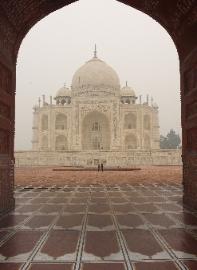
| India (Rajasthan) - Jan 2010 |
| Trip Highlights: Delhi Delhi, the capital of India, is divided into old and new. Old Delhi was the capital of Mughal India from 12th-19th centuries. Here you can find many mosques, monuments and forts relating to this period of India's history. The medieval atmosphere of the bazaars of Old Delhi contrasts sharply with the open, spacious streets of New Delhi - the imperial city created as the capital of India by the British Raj. Agra The Taj Mahal is one of the most fascinating and beautiful monuments of the world. Built in the 17th century by the Mughal emperor Shah Jahan as a tomb and memorial for his wife Mumtaz Mahal, it is a spellbinding sight that never disappoints. No picture or description of this magnificent white marble mausoleum can ever do it justice, and it is worth spending many hours in the gardens that surround the building, to see it from different angles and in different lights. About 20,000 workers were employed in its construction and it was completed after some 20 years. So perfect are the proportions of the Taj and so exquisite its workmanship that this is really one of the world's most marvellous buildings. Alongside the Yamuna River is the impressive Red Fort, from where there are fantastic views of the Taj Mahal. The Red Fort was the capital of the Mughal Empire and thus of India during the 16th and 17th centuries. Jaipur Jaipur is the capital of Rajasthan. With its faded pink buildings, many palaces and vibrant bazaars, Jaipur is one of the most exotic cities in India. Unlike most cities in India, which have developed in a haphazard way, this city was a planned one. Though it is rapidly expanding and has long ago outgrown the confines of its ancient walls, the Old City of Jaipur is still a fascinating and unique place. Known as the 'Pink City' because of the colour of these city walls, the street life has to be seen to be believed. With a chaotic mix of pedestrians, bicycles, cars, buses, trucks, camels and everything else besides, it is best experienced by taking a ride on a cycle rickshaw. Taking an excursion to the splendid Amber Fort, located 11 kilometres north of Jaipur is highly recommended. Pushkar Pushkar has a magnetism all of its own, and is quite unlike anywhere else in Rajasthan. It's a prominent Hindu pilgrimage town and devout Hindus should visit here at least once in their lifetime. The town curls around a holy lake, said to have appeared when Brahma dropped a lotus flower. Udaipur The famous lake city of Udaipur is one of the most romantic in the world. Set around the vast Pichola Lake and dominated by dramatic palaces, this is surely Rajasthan's most picturesque city. High whitewashed houses and narrow, winding alleys gives it an almost medieval charm. The huge City Palace, still the residence of the Maharana, is carved out of yellow sandstone and stands on the banks of Lake Pichola. From there you can enjoy fabulous views over the lake and the famous Lake Palace Hotel. The main part of the City Palace is now preserved as a museum with a large and varied collection of mosaics, glass and porcelain figures, miniatures and paintings. Jodhpur Jodhpur is the second largest city in Rajasthan, after Jaipur. The city is dominated by the massive Meherangarh Fort that sits atop a sheer rocky ridge right in the middle of town. The Old City is still surrounded by a 10-kilometre-long wall, built about a century after Jodhpur was founded in 1459 by the Rajput chief Rao Jodha. The clock tower is a popular landmark in the Old City. Narrow alleys lead from here to bazaars for textiles, silver and handicrafts. Jaisalmer Jaisalmer is an ancient trading town that resembles a scene from the classic story, 'One Thousand and One Nights'. Its inhabitants still live in the narrow paved streets and alleyways within the town's ancient fort. Jaisalmer is a great place to simply wander round and absorb its surreal ambience. The merchants and wealthy families of Rajasthan built magnificent homes or 'havelis' and some of the finest examples can be found here. Bikaner Bikaner is a desert outpost that was also a major trading centre on the old caravan route from central Asia. The city grew up around the fabulous Junagarh Fort, which is at its centre. The old city of Bikaner has a maze of narrow lanes and some beautifully-carved havelis in red sandstone. Karni Mata Temple (Rat Temple) at Deshnok The Karni Mata Temple (temple of rats) is one India's more challenging temples for Westerners - its resident mass of holy rodents is not for the squeamish. What may seem unusual to Western eyes is devoutly believed by pilgrims - remember that this isn't a sideshow but as place of worship. And don't conveniently forget to remove your shoes! |
